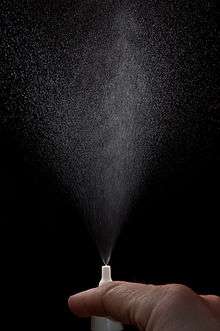Lip balm

Lip balm or lip salve is a wax-like substance applied topically to the lips of the mouth to moisturize and relieve chapped or dry lips, angular cheilitis, stomatitis, or cold sores. Lip balm often contains beeswax or carnauba wax, camphor, cetyl alcohol, lanolin, paraffin, and petrolatum, among other ingredients. Some varieties contain dyes, flavor, fragrance, phenol, salicylic acid, and sunscreens.
The primary purpose of lip balm is to provide an occlusive layer on the lip surface to seal moisture in lips and protect them from external exposure. Dry air, cold temperatures, and wind all have a drying effect on skin by drawing moisture away from the body. Lips are particularly vulnerable because the skin is so thin, and thus they are often the first to present signs of dryness. Occlusive materials like waxes and petroleum jelly prevent moisture loss and maintain lip comfort while flavorants, colorants, sunscreens, and various medicaments can provide additional, specific benefits.
Lip balm can be applied where a finger is used to apply it to the lips, or in a lipstick-style tube from which it can be applied directly.
Lip balm was first marketed in the 1880s by Charles Browne Fleet,[1] though its origins may be traced to earwax.[2] More than 40 years prior to the commercial introduction of lip balm by Fleet, Lydia Maria Child recommended earwax as a treatment for cracked lips in her highly-popular book, The American Frugal Housewife. Child observed that, "Those who are troubled with cracked lips have found this [earwax] remedy successful when others have failed. It is one of those sorts of cures, which are very likely to be laughed at; but I know of its having produced very beneficial results."[3]
Notable brands
- Baby Lips by Maybelline
- Burt's Bees
- Blistex
- Carmex
- ChapStick
- Labello
- Lip Smacker
- Lypsyl
- Tholene
- Vaseline
- Lip balm by Weleda
- Lip care by Nivea
- Revo by Walgreens
Dependency
Some physicians have suggested that certain types of lip balm can be addictive or contain ingredients that actually cause drying.[4] Lip balm manufacturers sometimes state in their FAQs that there is nothing addictive in their products or that all ingredients are listed and approved by the FDA. Snopes found the claim that there are substances in Carmex that are irritants necessitating reapplication, such as ground glass, to be false.[5]
References
- ↑ "The History of Chapstick - The History of Carmex". About.com. Retrieved 2010-06-30.
- ↑ Schwaab, M; Gurr, A; Neumann, A; Dazert, S; Minovi, A (2011). "Human antimicrobial proteins in ear wax". European Journal of Clinical Microbiology & Infectious Diseases. 30 (8): 997–1004. doi:10.1007/s10096-011-1185-2. PMID 21298458.
- ↑ Lydia Maria Francis Child (1833). The American Frugal Housewife. S.S. & W. Wood. p. 116.
- ↑ "Avoiding Lip Balm Addiction". CBS. Retrieved 1 October 2011.
- ↑ Lip Balm entry on snopes.com
-solution.jpg)


